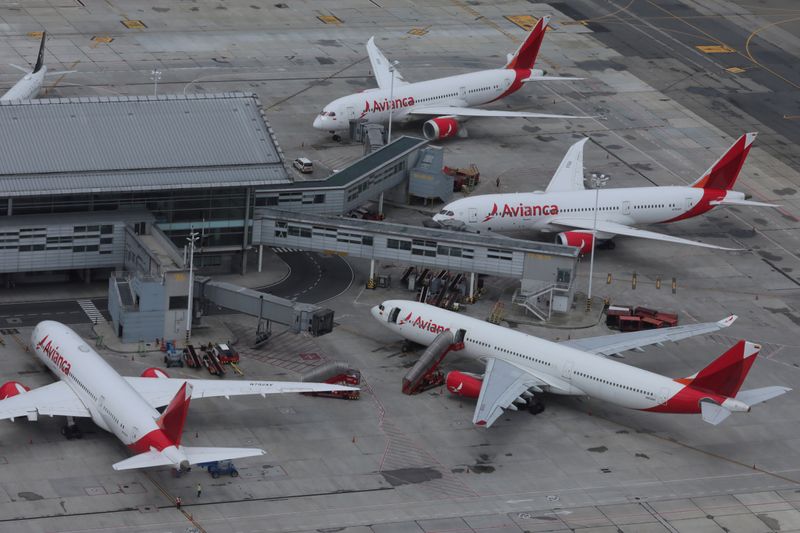This post was originally published on this site
https://i-invdn-com.akamaized.net/trkd-images/LYNXMPEG4C0V9_L.jpg
SAO PAULO (Reuters) – Avianca Holdings (NYSE:AVH) had known since late March that the Colombian airline’s cash pile would only cover a few months of expenses while its entire fleet sat grounded because of aggressive anti-coronavirus lockdowns.
In those conditions, Sunday’s bankruptcy filing was hardly a surprise. What was surprising was the absence of one key stakeholder: the Colombian government.
That stands in stark contrast to countries like France, Germany and the United States, which made protecting their airline industries an early priority of the crisis. At stake for Avianca, the world’s second-oldest airline, are 20,000 jobs, mostly in Colombia.
But Bogota’s mostly hands-off approach is hardly an exception among the Latin American governments, which have largely ignored the industry’s clamor for bailouts.
In public, LATAM Airlines Group (SN:LTM), Gol Linhas Aereas Inteligentes (SA:GOLL4), Aeromexico (MX:AEROMEX) and Avianca (CN:AVT_p), among others, say they are actively negotiating government rescue packages. But behind the scenes there is growing concern about when results may materialize and if it will not be too little too late.
“It is not coming fast enough,” said one airline source, who requested anonymity to not affect his carrier’s negotiations.
Avianca’s own numbers paint a grim picture for a carrier that recently showed enough promise to draw interest from United Airlines (O:UAL), which sought a close business partnership. At the start of the year, Avianca was worth $470 million – it is now worth $17 million, two pennies a share.
By the end of March, after a week on the ground, Avianca had $304 million in available cash with almost no money coming in and mounting expenses. By May, it would have used more than half of that just to make two months of payroll and settle a debt payment.
As the debt deadline approached, its chief executive Anko van der Werff publicized Avianca’s need. It was to no avail.
“In Latin America we have not seen as much (government) help as in other regions,” said Gonzalo Yelpo, legal director at ALTA, a regional airline industry group.
Analysts warn that the crisis could be particularly hazardous for carriers in the region, who lost money in recent years while most others basked in profits. ALTA has warned of a “bankruptcy pandemic.”
“The starting point is worse for Latin American airlines,” said Maurício França, of L.E.K Consulting, which estimates Brazil’s airlines lost 11 billion reais ($1.89 billion) between 2014 and late 2019.
Avianca’s bankruptcy could start to turn the tide, but it’s unclear how fast.
On Monday, Colombia said it would consider rescue loans for Avianca.
On Tuesday, Peru said it was considering helping carriers, including foreign airlines. But that comes too late for Avianca, which is shutting down its Peru operation and laying off 1,000 employees there.
In Brazil, airlines have been deadlocked on loan negotiations for weeks. Chile said “direct aid” was not on the table for LATAM, its largest carrier.
In Argentina and Mexico, left-wing governments have suggested they will not rescue big companies, although taxpayers directly own Aerolineas Argentinas, complicating the politics.
AIR TRAVEL GROUNDED
Avianca faced a perfect storm with its home base in Colombia and hubs in El Salvador, Ecuador and Peru.
Those four countries shut down all commercial air travel to protect their fragile healthcare systems. But it left Avianca grounded.
Avianca’s closest rival, LATAM, did not suffer to the same extent because it can still fly in Chile and Brazil, its main markets.
Now Avianca, which had agreed to buy more than 100 Airbus jets before 2029, faces an uphill path to recovery. It agrees it neither needs nor can afford those aircraft.
In the short-term, Avianca says it expects spending to significantly outpace its revenue, signaling that it “may eventually need a substantial new infusion of capital.”
Panama’s Copa Holdings SA (N:CPA), similarly grounded with nowhere to fly, is about a third smaller than Avianca and has said it was burning through $85 million a month.
Even at that rate, Avianca would have cash for less than four months. Almost two months have already gone by.
Making things worse, the coronavirus pandemic is at an earlier stage in Latin America than in the United States, Europe or Asia, pushing back any likely economic reopening.
“The shutdown in Latin America was in a way tighter and stronger,” said an industry source. “And now there’s bigger reluctance there on reopening the markets.”

